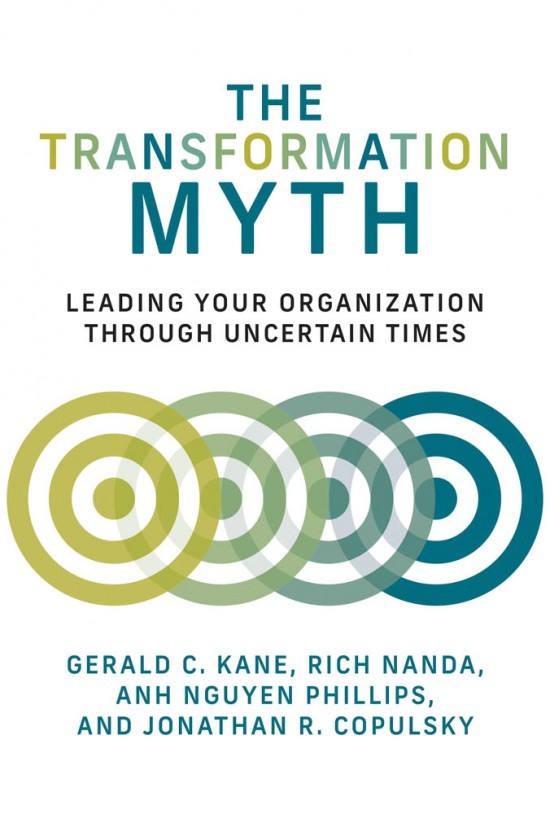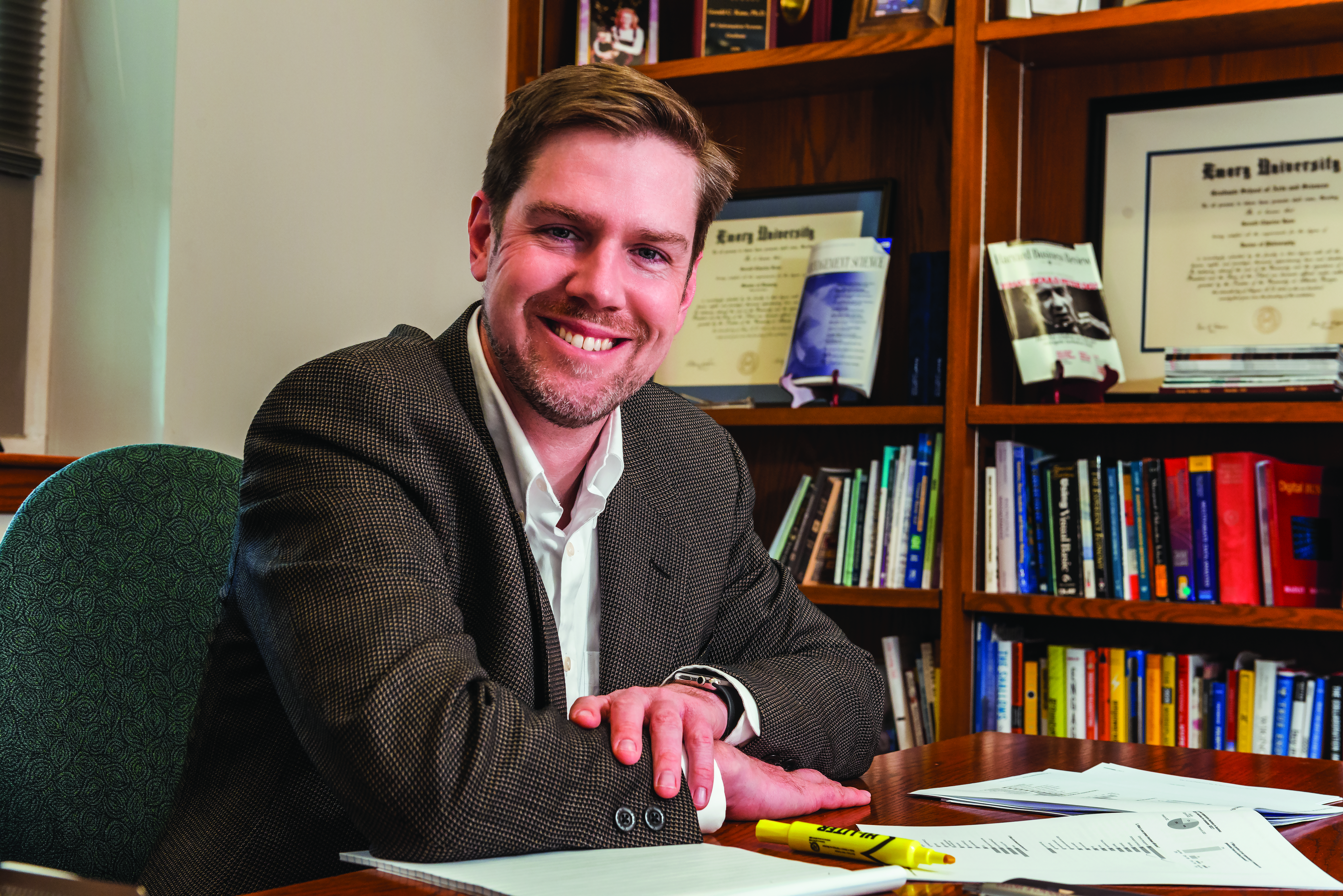Responding successfully to disruptions needs to become a habit, says new book co-authored by Carroll School professor
If it wasn’t already apparent, the COVID-19 pandemic—coming on the heels of Y2K, 9/11, the 2008 recession, the Black Lives Matter movement, and ongoing climate change—has alerted the world that seatbelts must be fastened—it’s going to be a bumpy century. Forward-thinking leaders must use every tool available to ready their organizations.
RELATED:

Information Systems Professor Gerald C. Kane
But transforming a company to respond successfully to disruptions is hardly a one-and-done proposition. It’s an ongoing process that had better become a habit, if it hasn’t already. So write Carroll School of Management Information Systems Professor Gerald C. Kane and co-authors in The Transformation Myth: Leading Your Organization through Uncertain Times, published in September by The MIT Press.
The authors write that they were prompted by the COVID-19 pandemic and the associated economic and social fallout to offer a guide for surviving inevitable future disruptions—and parlaying the lessons learned into greater growth. Through interviews and research, Kane and co-authors identify and describe the traits that characterize successful organizations and the characteristics of their leaders. They then provide a step-by-step analysis to help organizations understand where on the transformation continuum they currently stand and a framework for implementing transformation as a steady state.

“The core thesis of our book is that the companies that emerge stronger because of disruption are those that used it as an opportunity for innovation,” the authors write. In fact, their conversations with some 50 top executives and thought leaders suggest that business leaders agree strongly with that thesis: 75 percent of CEOs indicated that the COVID crisis created significant opportunities for their companies.
In addition to academic research that included surveying more than 21,000 people, the book relies on advisory work with companies to show they are practically navigating disruption to understand and evaluate possible responses. Professor Kane’s three co-authors—Rich Nanda, Anh Nguyen Phillips, and Jonathan R. Copulsky—are or have been management consultants at Deloitte. That collaboration has produced practical tools presented in the book, including simulation, to guide the reader on how to think about a problem; frameworks to help structure the problem; and checklists/questions to lead the reader to the outcomes they need.
Wanted: Digital Resilience
The authors point to the multiple and interacting disruptions that businesses have faced just in the past 25 years—add tsunamis, hurricanes, and wildfire disasters to the usual suspects. They make plain that disruptions must be perceived as frequent and not easily predicted. As a result, transformation must be ongoing, active, and continuous to make organizations stronger and more competitive in the face of the challenges.
For organizations to withstand or recover quickly from disruptive events, they need not just a set of digital skills but also a mindset the authors label “digital resilience.” Such an attitude combines the ability to regroup quickly from difficulties and setbacks with an appetite for new opportunities that may arise, plus perseverance or toughness.
In the era of advanced digital technologies such as cloud computing and AI, these tools and a digital infrastructure are sine qua non, but the authors emphasize they are not a panacea.
“We consciously try to keep the spotlight on the strategic, talent, leadership, organizational and cultural aspects of digital resilience that are so frequently overlooked in the face of shiny new digital tools,” they write. In other words, organizational concerns must be given as much attention in the transformational journey as technological building blocks. Diligent scenario planning that recognizes these concerns must be part of the process.
In October, The Wall Street Journal began excerpting and serializing selected conversations with leaders presented in the book. In one such conversation, Anthem Health’s chief digital officer described how artificial intelligence and predictive algorithms played a key role in helping the health benefits company accelerate and scale up its digital solutions for employees, clients, and consumers. The COVID crisis accelerated the company’s transformation process.
Book Draws Wide Attention
In October of last year, The Wall Street Journal began publishing excerpts from Professor Gerald Kane’s co-authored book, The Transformation Myth: Leading Your Organization through Uncertain Times (The MIT Press). A full year and 18 installments later, the series is still running.
One of those installments involved an interview with a Boston College parent, on how people-centered principles and adaptive innovation led Beam Suntory, a leading premium spirits provider, through the pandemic. Among other changes, the company dedicated an entire factory in Kentucky to producing hand sanitizer and created more e-commerce services to reach consumers, while keeping all of their employees during the pandemic. “We prioritized our people and their safety and capitalized on new trends when things were moving very, very quickly,” said president and CEO Albert Baladi, P ’19.
In September of this year, the MIT Sloan Management Review adapted a chapter of the book (under the title, “The Digital Superpowers You Need to Thrive”) for its September 28 edition. Kane also spoke on The Financial Brand’s “Banking Transformed” podcast about the interviews and research he conducted for The Transformation Myth, and how financial institutions can use disruptions—such as the pandemic—as opportunities to innovate.
—Carroll School News
Using AI to Help the Vulnerable
Thanks to the data and AI capabilities already in place, Anthem was able rapidly to identify and contact its most vulnerable members more efficiently—for example, by helping transfusion patients receive their care at home when a trip to the hospital was prohibitive. “The pandemic has shown that a care pattern can combine digital and virtual capabilities to serve consumers’ needs,” the CDO explains. “We’ve seen a pattern emerge where digital is the first line of defense; you can escalate to virtual and physical care as needed. Data is the foundation that links all three care models.”
Another critical capability identified in the book is scalability. As the hotel industry crashed in 2020 and Hilton had to furlough tens of thousands of employees, it tweaked its existing digital infrastructure in the service of human resources, scaling up and retooling its own recruitment platform to help employees find short-term jobs elsewhere. At one point the company’s job engine listed 1.2 million positions. Through its online resource center, Hilton provided employees access to job hunting technology and career tools, and most importantly it partnered with dozens of companies that were hiring—in many cases reaching out to advocate on their employees’ behalf.
Kane and co-authors point out that if a company were able to layer stability on top of nimbleness and scalability, then maintaining operational excellence in the face of disruption could produce outstanding performance—as did Pfizer in 2020, when it developed a COVID-19 vaccine in record time. The company’s pre-pandemic and continuing investments in digital R&D and AI enabled it to move swiftly when it had to. But without the safety and security standards it had been maintaining, it couldn’t have delivered hundreds of millions of usable, effective, trustworthy doses of its mRNA vaccine.
Given the successes of many companies during the past quarter century of crises, the authors see reason for optimism.
“The acute COVID disruption did not lead most organizations to do fundamentally different things than they were already contemplating; it simply forced action and transformation with urgency and at scale,” they write. “Transformation success during the pandemic has fueled new confidence and optimism about our ability to harness disruption. We argue that leaders should also apply the core lesson of the book to the disruption caused by widespread vaccination that allows safe return to public spaces—innovate through it. The post-pandemic world will be fundamentally different than the one that existed before or during the acute covid disruption. It is in precisely this way we hope readers will use this book and the tool we provide.”
—Carroll School News



